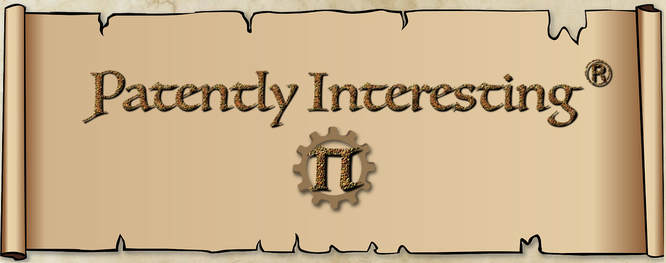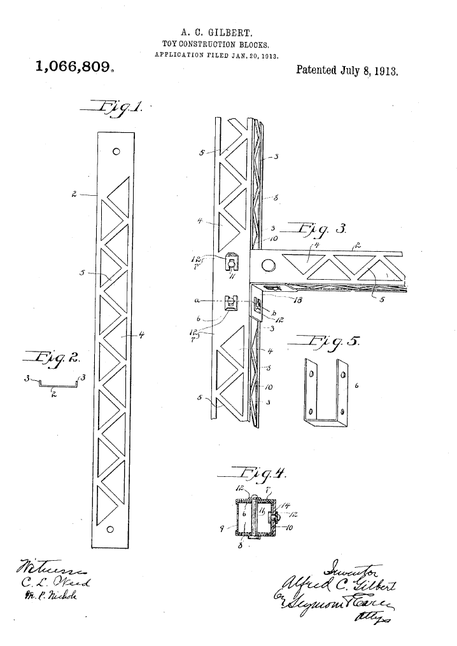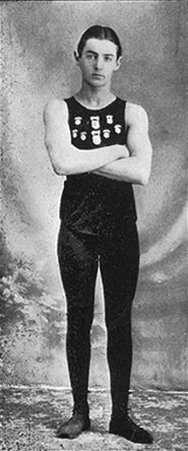 A.C. Gilbert
A.C. Gilbert
On July 8 of the year 1913, U.S. Patent No.: 1,066,809 issued to Alfred Carlton Gilbert for "Toy Construction Blocks". The toy blocks of the '809 patent formed the basis of a toy set that Gilbert sold under the trademark "Erector Set". Gilbert initially sold Erector Sets through the Mysto Manufacturing Company, which Gilbert had started with his college friend, John Petrie, in 1909 to sell magic kits. The company was later reorganized to become the A.C. Gilbert Company, which continued to sell magic kits, as well as Erector Sets and other knowledge-based toys for children. At one point, the A.C. Gilbert Company was one of the largest toy companies in the world.
Gilbert did not originally start out to become a successful businessman. His initial interest was sports, which he exelled at, particularly football, wrestling and track and field. Gilbert's love of sports led him to Yale University, where he studied medicine in the belief that it would make him a better coach and prepare him to become a university athletic director. In order to pay for his studies, Gilbert performed magic, which he also had a talent for.
While at Yale University, Gilbert competed in pole vaulting, which he revolutionized with several innovations. At the time, pole vaulters used a long, rigid hickory pole with a six-inch metal spike affixed to the end, which would be driven into the ground as the pole vaulter launched themselves upward and over the cross bar. After reading about a Japanese athlete's use of bamboo for pole vaulting, Gilbert became the first American to use a bamboo pole in competition. The bamboo pole that Gilbert used was significantly shorter than the conventional hickory poles and did not have a spike. Instead, Gilbert would dig a hole in the gound, below the cross bar, to receive the end of his bamboo pole, as he vaulted over the cross bar. Since he used a shorter pole, Gilbert had to lift his body significantly higher than the position of his hands on the pole in order to clear the cross bar.
Gilbert did not originally start out to become a successful businessman. His initial interest was sports, which he exelled at, particularly football, wrestling and track and field. Gilbert's love of sports led him to Yale University, where he studied medicine in the belief that it would make him a better coach and prepare him to become a university athletic director. In order to pay for his studies, Gilbert performed magic, which he also had a talent for.
While at Yale University, Gilbert competed in pole vaulting, which he revolutionized with several innovations. At the time, pole vaulters used a long, rigid hickory pole with a six-inch metal spike affixed to the end, which would be driven into the ground as the pole vaulter launched themselves upward and over the cross bar. After reading about a Japanese athlete's use of bamboo for pole vaulting, Gilbert became the first American to use a bamboo pole in competition. The bamboo pole that Gilbert used was significantly shorter than the conventional hickory poles and did not have a spike. Instead, Gilbert would dig a hole in the gound, below the cross bar, to receive the end of his bamboo pole, as he vaulted over the cross bar. Since he used a shorter pole, Gilbert had to lift his body significantly higher than the position of his hands on the pole in order to clear the cross bar.
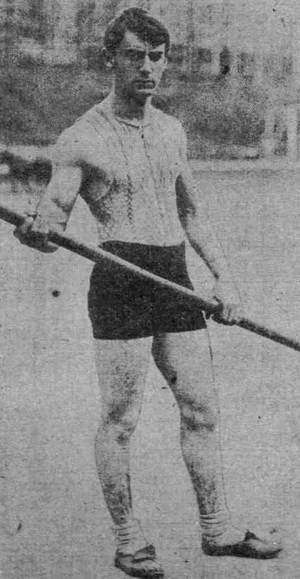 A.C. Gilbert in 1908
A.C. Gilbert in 1908
Gilbert used his innovative equipment and technique in June of 1908 in Philadelphia to set the world record for pole vaulting with a height of 12 feet, 7 and 3/4 inches. Gilbert's record earned him a spot on the U.S. Olympic team, which competed in the 1908 Olympic Games in London. Being the world record holder, Gilbert was the overwhelming favorite to win the gold medal. However, British officials would not allow Gilbert to use his bamboo pole or dig a hole below the cross bar, even though there was nothing in the rules prohibiting it.
Forced to use an unfamiliar wooden pole with a spike, Gilbert still finished second in the preliminaries to his teammate, Edward Tiffin Cook Jr., with Gilbert jumping 12 feet and Cook jumping 12 feet, 2 inches. Not to be outdone, Gilbert won the finals with a jump of 12 feet, 2 inches, while Cook finished second with a jump of 11 feet, 9 inches. Inexplicably, however, British officials declared a tie and awarded the gold medal to both Gilbert and Cook.
Gilbert's experience at the Olympics soured him on sports and most likely discouraged him from pursuing a career in the field. While he completed his medical degree in 1909, Gilbert decided to instead pursue business as his career, starting with the Mysto Manufacturing Company and their magic kits.
In 1911, Gilbert got the idea for the Erector Set while traveling on the New Haven Railroad, which was being converted from steam power to electric power. Gilbert was fascinated by the girder construction of the towers being erected to carry the power lines for the railroad and decided to develop a toy for making simulated girders. The result was the invention of the '809 patent.
The '809 patent was directed to components for making a box girder. The components included strips of sheet metal, each of which comprised a main face stamped to have the appearance of a truss formed by beams. A pair of flanges were joined to opposing, longitudinal edges of the main face, respectively, and extended outwardly therefrom. Holes were provided in opposing ends of the main face of each strip. Four strips were secured together using a U-shaped clip to form the box girder, with the flanges of two strips extending over the main faces of two other two strips and the clip disposed inside. The strips were held together by nuts and bolts extending through the holes in the strips and corresponding holes in the clip.
Forced to use an unfamiliar wooden pole with a spike, Gilbert still finished second in the preliminaries to his teammate, Edward Tiffin Cook Jr., with Gilbert jumping 12 feet and Cook jumping 12 feet, 2 inches. Not to be outdone, Gilbert won the finals with a jump of 12 feet, 2 inches, while Cook finished second with a jump of 11 feet, 9 inches. Inexplicably, however, British officials declared a tie and awarded the gold medal to both Gilbert and Cook.
Gilbert's experience at the Olympics soured him on sports and most likely discouraged him from pursuing a career in the field. While he completed his medical degree in 1909, Gilbert decided to instead pursue business as his career, starting with the Mysto Manufacturing Company and their magic kits.
In 1911, Gilbert got the idea for the Erector Set while traveling on the New Haven Railroad, which was being converted from steam power to electric power. Gilbert was fascinated by the girder construction of the towers being erected to carry the power lines for the railroad and decided to develop a toy for making simulated girders. The result was the invention of the '809 patent.
The '809 patent was directed to components for making a box girder. The components included strips of sheet metal, each of which comprised a main face stamped to have the appearance of a truss formed by beams. A pair of flanges were joined to opposing, longitudinal edges of the main face, respectively, and extended outwardly therefrom. Holes were provided in opposing ends of the main face of each strip. Four strips were secured together using a U-shaped clip to form the box girder, with the flanges of two strips extending over the main faces of two other two strips and the clip disposed inside. The strips were held together by nuts and bolts extending through the holes in the strips and corresponding holes in the clip.
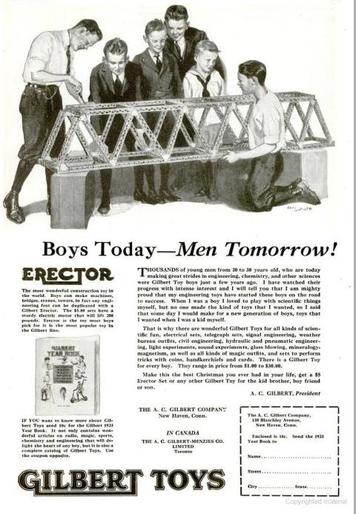 Advertisement for Erector Set
Advertisement for Erector Set
The first Erector Set was sold in 1913 at the Toy Fair held at the Broadway Central Hotel in New York City. While the '809 patent was limited to the components for making a box girder, the commercially-sold Erector Set included additional mechanical parts, such as hubs and plates for making pulleys. Different length strips were provided and they only had a single flange, instead of the two disclosed in the '809 patent. New parts were continuously added, such that by 1924, the Erector Set included more than 70 different parts. These new parts included pulleys, gears, an electric motor and electric lights.
The Erector Set was popular from the beginning and sold well for almost sixty years. Its popularity was mainly attributable to its numerous and versatile parts that enabled a child to build a model, then take it apart and build something else, over and over again. In 1998, the Erector Set was inducted into the National Toy Hall of Fame.
The Erector Set was popular from the beginning and sold well for almost sixty years. Its popularity was mainly attributable to its numerous and versatile parts that enabled a child to build a model, then take it apart and build something else, over and over again. In 1998, the Erector Set was inducted into the National Toy Hall of Fame.

